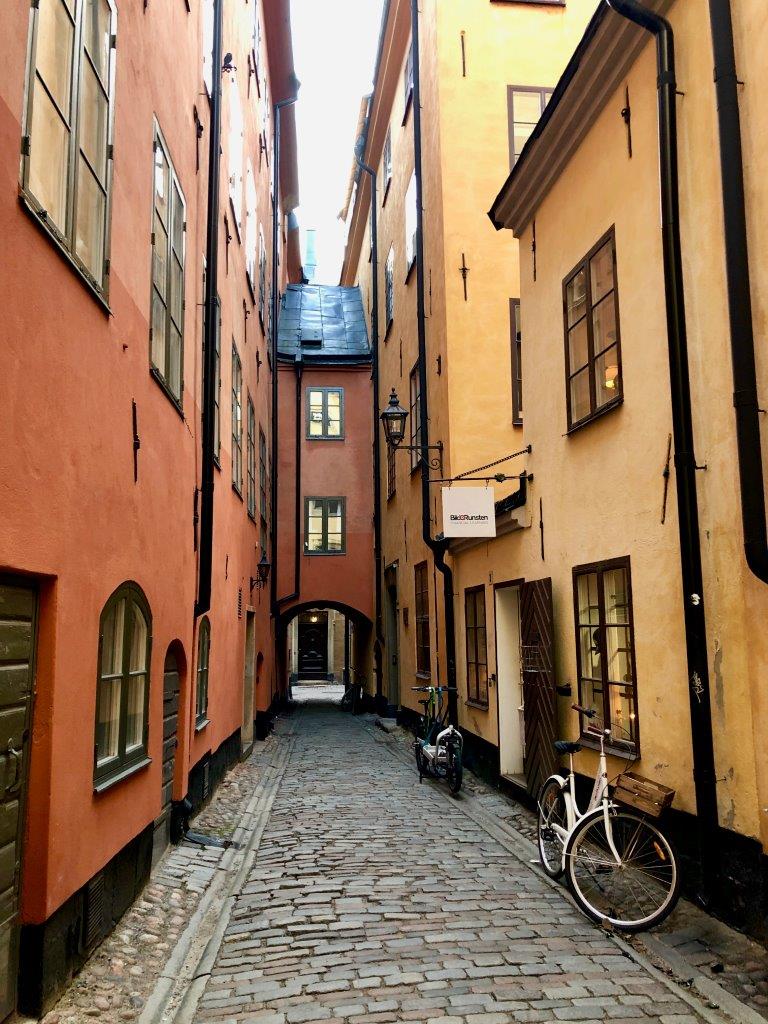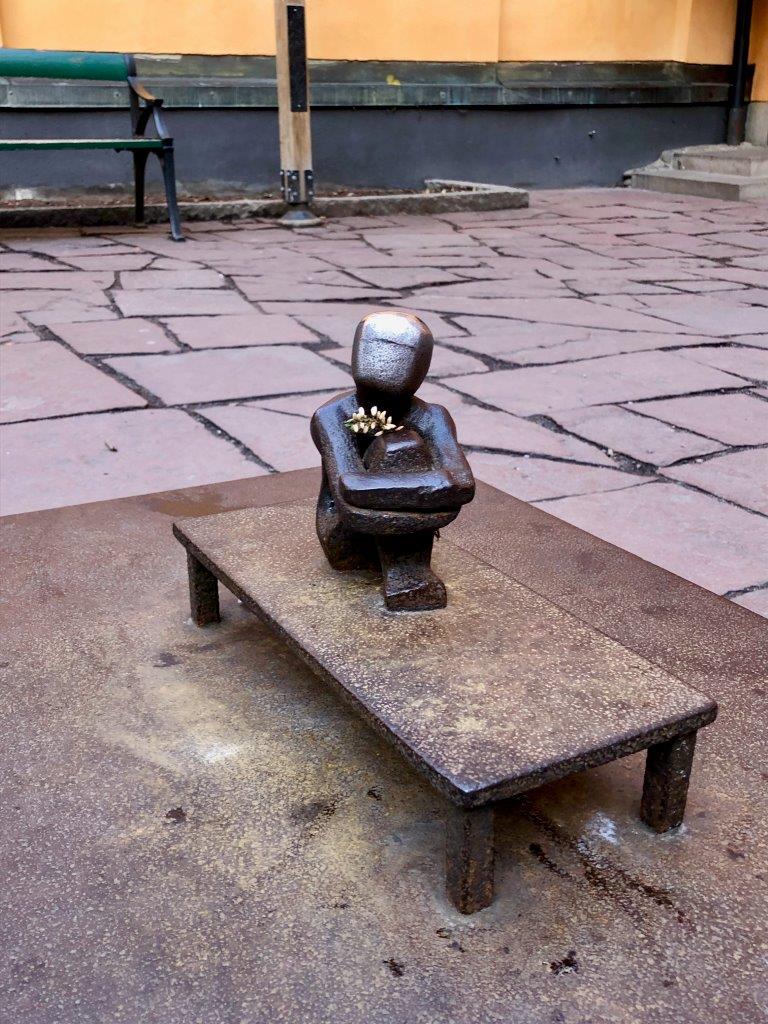stockholm
See it like a local
By Katharine Trigarszky Katharine is a British writer and editor for whom Stockholm has been home for the past decade. She has written about living abroad, Swedish life and culture, and the city of Stockholm for different sites. She has also recently published a two-day walking guide to the city https://www.amazon.com/Stockholm-Travel-Guide-Unanchor-Islands-ebook/dp/B081SC1HHJ/

You might have heard that Stockholm is surrounded by water, but it is only when you arrive in the city that you discover the extent to which this is true. The city spreads itself across 14 islands, lapped by Lake Mälaren on one side and the waters of the Baltic Sea on the other. It’s everywhere; even in the city’s parks and squares, fountains and ponds abound.
The other rumour you might have heard about Stockholm is just how expensive it is. But it doesn’t have to be. As in many capital cities, you can throw caution to the wind and spend big in Stockholm, but there are also many opportunities to save your kronor.
Stockholm is no vast urban sprawl like London or Berlin; the city centre is walkable while the public transport system is easy to navigate and offers 24-hour or 72-hour tickets to save on individual fares. But slipping on a pair of comfy shoes and navigating the city by foot is by far the best way to see it.
Most visitors start with Gamla Stan (the Old Town), which is the medieval heart of Stockholm, and it’s easy to see why. This densely packed island offers a glimpse into the Stockholm of centuries past, with narrow alleys, brightly painted buildings and a sense that you’ve travelled back in time, provided you avoid the tourist shops lining the crowded main street of Västerlånggatan.
The best way to experience Gamla Stan is to pick a handful of streets to wander along to try to stay away from the tours. The northern end of Prästgatan (nearest to the Royal Palace), Själagårdsgatan, and Finska Kyrkogränd are among the most atmospheric.
This last alley takes you past Finska Kyrkan (the Finnish Church), where you’ll find Stockholm’s smallest statue in the church’s courtyard. Järnpojken is a little boy, just 15cm high, who sits gazing up at the sky. In winter he is often given a tiny knitted scarf and hat by kindly Stockholmers, while in the summer he is sometimes found with a small parasol to protect him from the sun.
The other rumour you might have heard about Stockholm is just how expensive it is. But it doesn’t have to be. As in many capital cities, you can throw caution to the wind and spend big in Stockholm, but there are also many opportunities to save your kronor.
Stockholm is no vast urban sprawl like London or Berlin; the city centre is walkable while the public transport system is easy to navigate and offers 24-hour or 72-hour tickets to save on individual fares. But slipping on a pair of comfy shoes and navigating the city by foot is by far the best way to see it.
Most visitors start with Gamla Stan (the Old Town), which is the medieval heart of Stockholm, and it’s easy to see why. This densely packed island offers a glimpse into the Stockholm of centuries past, with narrow alleys, brightly painted buildings and a sense that you’ve travelled back in time, provided you avoid the tourist shops lining the crowded main street of Västerlånggatan.
The best way to experience Gamla Stan is to pick a handful of streets to wander along to try to stay away from the tours. The northern end of Prästgatan (nearest to the Royal Palace), Själagårdsgatan, and Finska Kyrkogränd are among the most atmospheric.
This last alley takes you past Finska Kyrkan (the Finnish Church), where you’ll find Stockholm’s smallest statue in the church’s courtyard. Järnpojken is a little boy, just 15cm high, who sits gazing up at the sky. In winter he is often given a tiny knitted scarf and hat by kindly Stockholmers, while in the summer he is sometimes found with a small parasol to protect him from the sun.
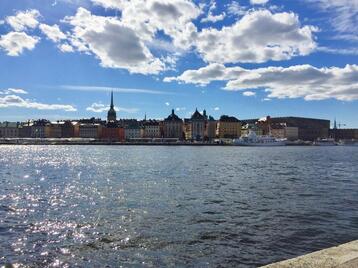
As Stockholm is built across islands and hills, you’ll find a choice of spots affording some incredible views of the city. Fjällgatan and Monteliusvägen on the hip island of Södermalm are among the most popular – offering stunning vistas of the city centre – and Stockholmers also come here to take a coffee or ice cream at Fjällgatans Kaffestuga and admire their town. A short walk around the small islands of Skeppsholmen and Kastellholmen can also provide you with superb views of Gamla Stan and Södermalm.
Skeppsholmen is also home to Moderna Museet, Stockholm’s modern art gallery. Much of this museum is free to enter, with only the temporary exhibitions charging an entrance fee. Come to see works by Pablo Picasso, Edvard Munch and Hilma af Klint, and stay for the views from the museum’s restaurant. Large windows offer vistas of the upmarket Östermalm district and the island of Djurgården.
Skeppsholmen is also home to Moderna Museet, Stockholm’s modern art gallery. Much of this museum is free to enter, with only the temporary exhibitions charging an entrance fee. Come to see works by Pablo Picasso, Edvard Munch and Hilma af Klint, and stay for the views from the museum’s restaurant. Large windows offer vistas of the upmarket Östermalm district and the island of Djurgården.
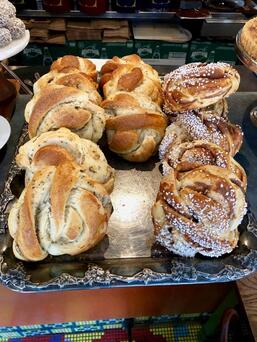
Stockholmers often spend time on Djurgården thanks to its proximity to the city centre. Not only is this former royal hunting ground known as the “museum island” but beyond the Vasa Museum, open-air museum Skansen, and the ABBA Museum, it also offers beautiful walks and cycle routes skirting the water or winding through the woods, plus a number of spots to partake of fika – the uniquely Swedish concept of stopping for a coffee and cake (typically a cinnamon or cardamon bun) with friends.
Fika is an essential part of life in Sweden. It is encouraged in the workplace as a chance for colleagues to take a break from work and chat informally, over a hot drink and sweet snack, and it offers an easy way for busy Swedes to catch up with friends and acquaintances. It is one of the first words that you learn in Swedish, after hello (hej) and thank you (tack).
Among the best places to grab a fika on Djurgården are the small Flickorna Helin Skånska Gruvan and the delightful Rosendals Trädgården, where you can also buy plants from the stunning gardens or a loaf or two of their home-baked bread.
Fika is an essential part of life in Sweden. It is encouraged in the workplace as a chance for colleagues to take a break from work and chat informally, over a hot drink and sweet snack, and it offers an easy way for busy Swedes to catch up with friends and acquaintances. It is one of the first words that you learn in Swedish, after hello (hej) and thank you (tack).
Among the best places to grab a fika on Djurgården are the small Flickorna Helin Skånska Gruvan and the delightful Rosendals Trädgården, where you can also buy plants from the stunning gardens or a loaf or two of their home-baked bread.

If your hunger cannot be sated by baked goods alone, then it’s probably time for lunch. It can be easy to find a good value lunch in the city as most restaurants, even the higher-end ones, offer a lunch dish of the day (dagens lunch/dagens rätt), which often includes a small side salad and a coffee. Dagens lunch typically costs 110-140 Skr (£9-11 / $11-14.50) and is a popular way to eat at a great restaurant for a more reasonable price.
Stockholmers tend to eat lunch early, so don’t surprised that restaurants are busy immediately on opening at 11am. Most office workers make sure to leave their desks for a proper lunch and chat with their colleagues or friends.
Some options for a delicious lunch in the city are Häktet on Södermalm, a former prison converted into a restaurant, which spills over into a lively bar in the evenings; Teatern, also on Södermalm, which offers a range of different cuisines from some famous Swedish restaurateurs – the quality of the food here far exceeds what you’d usually expect from a food court; Nalen in the city centre, which offers lunch for 115 Skr if you visit between 1pm and 3pm; and the nearby K25, another food court that will make you rethink that concept, providing everything from burgers to sushi.
Heading over to Södermalm, you can walk off your lunch in different ways. In the middle of the island, the hip SoFo (south of Folkungagatan) neighbourhood is a vintage and boutique shopping mecca, while the hilly area around Mosebacke Torg and Södra Teatern – a must-visit venue for a drink, especially in the summer when the terrace is open – takes you back in time to when Södermalm was home to the city’s working class families. Mäster Mikaels gata is an atmospheric little street of red, orange and yellow wooden houses, some dating back to the 1730s.
Stockholmers tend to eat lunch early, so don’t surprised that restaurants are busy immediately on opening at 11am. Most office workers make sure to leave their desks for a proper lunch and chat with their colleagues or friends.
Some options for a delicious lunch in the city are Häktet on Södermalm, a former prison converted into a restaurant, which spills over into a lively bar in the evenings; Teatern, also on Södermalm, which offers a range of different cuisines from some famous Swedish restaurateurs – the quality of the food here far exceeds what you’d usually expect from a food court; Nalen in the city centre, which offers lunch for 115 Skr if you visit between 1pm and 3pm; and the nearby K25, another food court that will make you rethink that concept, providing everything from burgers to sushi.
Heading over to Södermalm, you can walk off your lunch in different ways. In the middle of the island, the hip SoFo (south of Folkungagatan) neighbourhood is a vintage and boutique shopping mecca, while the hilly area around Mosebacke Torg and Södra Teatern – a must-visit venue for a drink, especially in the summer when the terrace is open – takes you back in time to when Södermalm was home to the city’s working class families. Mäster Mikaels gata is an atmospheric little street of red, orange and yellow wooden houses, some dating back to the 1730s.
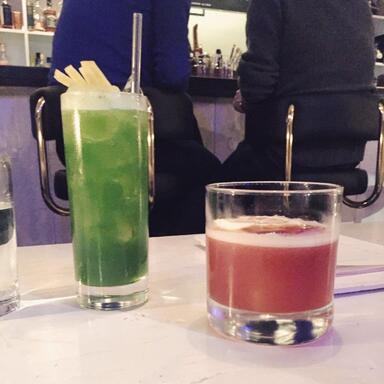
On a warm, sunny day, you can head to the north western end of Södermalm and onto the small island of Långholmen for a dip in the waters of Lake Mälaren. The north side of Långholmen has a handful of small beaches where Stockholmers gather in the summer to bathe and soak up the sun. The island was the site of Stockholm’s prison until 1975, a building that has now been converted into a hotel and restaurant.
At the end of the day, heading to the residential neighbourhood of Vasastan gives you all the best dinner options for eating like a local. This area, just north of the city centre, is bursting with restaurants and bars, with some streets offering a wide range of cuisines. The southern end of Roslagsgatan and almost all of Rörstrandsgatan deserve particular mention for their choice of dining spots.
As this is a northern European capital, Stockholmers usually eat dinner early, around 8pm, and you’ll need to bear in mind that many restaurants’ kitchens close at around 10pm or 10.30pm. Luckily, many of these restaurants have a bar area and there’s also a selection of bars in the area. Popular spots include Las Brasas and Buco Nero on Roslagsgatan (both of which have bars), Svartengrens on Surbrunnsgatan (also with a small and inventive cocktail bar), and Levinsky’s on Rörstrandsgatan.
If you want to push the boat out, Jim & Jacob on Surbrunnsgatan is a petite but delightful restaurant with charming staff, while Farang on Tulegatan offers a modern take on Asian fusion cuisine, with a creative cocktail bar out front.
Experiencing Stockholm like a local is all about indulging. Indulging in the views, the history, and the food.
Insider tip: One thing to bear in mind when visiting Stockholm is that cash is definitively not king. You’ll be hard pressed to spend cash, as most shops and restaurants now only take electronic payments. Make sure you have your cards to hand so that you don’t find yourself stuck unable to buy that cinnamon bun you’re hankering after.
For more information go to Visit Stockholm https://www.visitstockholm.com which includes information on which museums offer free entry at https://www.visitstockholm.com/guides/museums-with-free-entry
At the end of the day, heading to the residential neighbourhood of Vasastan gives you all the best dinner options for eating like a local. This area, just north of the city centre, is bursting with restaurants and bars, with some streets offering a wide range of cuisines. The southern end of Roslagsgatan and almost all of Rörstrandsgatan deserve particular mention for their choice of dining spots.
As this is a northern European capital, Stockholmers usually eat dinner early, around 8pm, and you’ll need to bear in mind that many restaurants’ kitchens close at around 10pm or 10.30pm. Luckily, many of these restaurants have a bar area and there’s also a selection of bars in the area. Popular spots include Las Brasas and Buco Nero on Roslagsgatan (both of which have bars), Svartengrens on Surbrunnsgatan (also with a small and inventive cocktail bar), and Levinsky’s on Rörstrandsgatan.
If you want to push the boat out, Jim & Jacob on Surbrunnsgatan is a petite but delightful restaurant with charming staff, while Farang on Tulegatan offers a modern take on Asian fusion cuisine, with a creative cocktail bar out front.
Experiencing Stockholm like a local is all about indulging. Indulging in the views, the history, and the food.
Insider tip: One thing to bear in mind when visiting Stockholm is that cash is definitively not king. You’ll be hard pressed to spend cash, as most shops and restaurants now only take electronic payments. Make sure you have your cards to hand so that you don’t find yourself stuck unable to buy that cinnamon bun you’re hankering after.
For more information go to Visit Stockholm https://www.visitstockholm.com which includes information on which museums offer free entry at https://www.visitstockholm.com/guides/museums-with-free-entry
|
Images copyright of the author
Click on any image to enlarge it |
